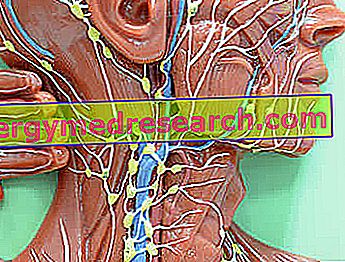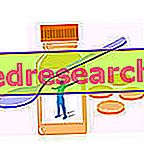Swollen lymph nodes may be the result of acute (lymphadenitis) or chronic adenopathy.

There are some pathologies of the lymph nodes that appear in the absence of inflammation and can be idiopathic, clinically not very relevant, or constitute the clinical sign of serious pathologies.
The swollen lymph nodes appear above all in the areas of: neck, armpits and groin; sometimes in the abdominal and / or mediastinal area.
What to do
- The presence of swollen lymph nodes requires a fairly rapid medical consultation, as the causes can be trivial or very serious.
- The specialist will carry out a clinical evaluation (presence of inflammation, lymph node size etc.) and will start the search for the triggering causes:
- Infections (bacterial, fungal, parasitic or viral): for example mononucleosis, toxoplasmosis, tuberculosis, AIDS and paracoccidioidomycosis.
- Rheumatic fever: typical symptom of generalized inflammation in response to group A streptococcal infection.
- PFAPA syndrome (periodic fever with aphthous stomatitis): typical of children. It is probably caused by a disturbance in the mechanisms of control of inflammation or by the reactivation of the latent adenovirus.
- Idiopathic lymphadenopathy.
- Tumors or metastases.
- Sarcoidosis: systemic inflammatory disease.
- Depending on the related symptoms, the doctor will be able to immediately identify the aetiology or prescribe some diagnostic insights:
- Blood analysis.
- Ultrasound or other imaginographic analyzes.
- Agospirato.
- Biopsy.
- It is essential to support the immune system with diet and supplements to treat swollen lymph nodes.
WARNING! Since statistically the most frequent causes of swollen lymph nodes are: respiratory and ear infections, mononucleosis, rheumatic fever, PFAPA, toxoplasmosis and tuberculosis, below we will quote remedies aimed at treating these pathologies.
- In case of respiratory and ear infections:
- Rest.
- Pharmacological therapy.
- Sometimes surgery is used: adenoidectomy and tonsillectomy.
- In the case of mononucleosis, rheumatic fever, PFAPA and toxoplasmosis:
- Healing occurs spontaneously (for mononucleosis in two or three weeks, but the virus remains latent even for months).
- Drug therapy may be helpful.
- Invasive medical treatments are rarely used.
- In case of tuberculosis:
- For the latent form: chemoprophylaxis.
- For the active form: antituberculous antibiotic therapy.
What NOT to do
- To smoke.
- Overdo it with alcohol.
- Increase the risk of cancer by adopting inappropriate behaviors and neglecting controls.
- In the case of infectious disease, lead a normal life without allowing yourself the right rest. Such an attitude can prolong the healing time and increase the risk of relapse.
- In children, give acetylsalicylic acid: it can cause a serious complication called Reye's syndrome.
- Provide prednisolone in a prolonged or massive manner: it can promote osteoporosis, hypertension, increased body weight, etc.
- In the case of mononucleosis and splenomegaly (enlargement of the spleen), undergo physical trauma (contact sports, falls, etc.): the spleen can be severely damaged causing hemorrhage.
- Delaying the diagnosis for toxoplasmosis during pregnancy.
- Refuse drug therapy. It can increase the risk of complications, such as the transit of the toxoplasma from the mother to the fetus.
- Refuse surgical removal of lymph nodes, if recommended by your doctor.
What to eat
- There is no specific diet. In general:
- Maintaining the trophism of the intestinal bacterial flora, since it seems partly responsible for the immune support:
- Probiotic foods: enrich the intestinal bacterial flora and can improve bowel health. Some are: yogurt, buttermilk, kefir, tofu, tempeh, miso, kombucha, sauerkraut, gherkins, etc. It must be remembered that the acidic barrier of the stomach eliminates most of the microorganisms and for this purpose it can be useful to also take supplements and drugs.
- Prebiotic foods: are those containing soluble fiber and various carbohydrates (available or not available to humans) that nourish the physiological bacteria of the colon. They are found in: vegetables, fruits, cereals, legumes, potatoes.
- Nutrients that support the immune system:
- Vitamin C or ascorbic acid: it is contained above all in the acidulous fruit and in the raw vegetables. In particular: peppers, lemon, orange, grapefruit, mandarancio, parsley, kiwi, lettuce, apple, chicory, cabbage, broccoli etc.
- Vitamin D or calciferol: it is mainly contained in: fish, fish oil and egg yolk.
- Magnesium: it is mainly contained in: oilseeds, cocoa, bran, vegetables and fruits.
- Iron: it is mainly contained in: meat, peach and egg yolk.
- Lysine and glycine amino acids: they are mainly contained in: meat, fishery products, cheeses and legumes (especially soya).
- Increase the intake of anti-inflammatory and antioxidant molecules:
- Omega 3: are eicosapentaenoic acid (EPA), docosahexaenoic (DHA) and alpha linolenic acid (ALA). They play an anti-inflammatory role. The first two are biologically very active and are found mainly in: Sardinian, mackerel, bonito, alaccia, herring, alletterato, ventresca of tuna, needlefish, algae, krill etc. The third is less active but constitutes a precursor of EPA; it is mainly contained in the fat fraction of certain foods of vegetable origin or in the oils of: soy, linseed, kiwi seeds, grape seeds, etc.
- Vitamins: carotenoids (provitamin A), vitamin C and vitamin E. Carotenoids are contained in vegetables and red or orange fruits (apricots, peppers, melons, peaches, carrots, squash, tomatoes, etc.); they are also present in shellfish and milk. Vitamin C is typical of sour fruit and some vegetables (lemons, oranges, mandarins, grapefruit, kiwi, peppers, parsley, chicory, lettuce, tomatoes, cabbage, etc.). Vitamin E is available in the lipid portion of many seeds and related oils (wheat germ, maize germ, sesame, kiwi, grape seeds, etc.).
- Minerals: zinc and selenium. The first is mainly contained in: liver, meat, milk and derivatives, some bivalve molluscs (especially oysters). The second is contained above all in: meat, fishery products, egg yolk, milk and dairy products, fortified foods (potatoes, etc.).
- Polyphenols: simple phenols, flavonoids, tannins. They are very rich: vegetables (onion, garlic, citrus fruits, cherries, etc.), fruit and related seeds (pomegranate, grapes, berries, etc.), wine, oilseeds, coffee, tea, cocoa, legumes and whole grains, etc.
What NOT to Eat
- There are no foods less recommended than others. To maintain nutritional balance it is recommended to avoid:
- Monothematic diets.
- Vegan diet.
- Diet free of vegetables and vegetables.
- Diets based solely on:
- Cooked foods.
- Preserved foods.
- Avoid alcohol abuse. It compromises metabolism, intestinal absorption and general health.
- Avoid milk and dairy products, if responsible for interactions with the prescribed antibiotic.
- Avoid foods at risk of toxoplasma contamination.
Natural Cures and Remedies
- Natural remedies are mainly herbal in nature, but the choice depends on the causative agent. The main characteristics must be: anti-inflammatory, antipyretic, antibacterial, antiviral and antifungal. Some examples are:
- Propolis.
- Boswellic acid.
- Essential oils of thyme, lemon, oregano, mint, rosemary.
- Curcumin.
- Devil's claw.
- Euonymus alatu.
- Tripterygium wilfordii (can cause serious side effects).
- Garlic and onion.
- Chili pepper.
- Echinacea.
- Eucalyptus.
- Goldenseal.
- Elder.
- Lime.
- Chamomile.
- Willow bark.
Pharmacological care
- In case of respiratory and ear infections:
- Non-steroidal anti-inflammatories, analgesics and antipyretics:
- Paracetamol (eg Tachipirina and Efferalgan).
- Ibuprofen (eg brufen and moment).
- If necessary:
- Antibiotics:
- Clarithromycin (eg Biaxin, Macladin).
- Amoxicillin (eg Augmentin).
- Telithromycin (eg Ketek).
- Antiviral drugs (generally associated with serious pathological conditions).
- Antifungals for fungal infections.
- In the case of mononucleosis and rheumatic fever:
- Analgesics: acetaminophen and ibuprofen.
- Antipyretics (paracetamol and all non-steroidal anti-inflammatory drugs).
- Non-steroidal anti-inflammatory drugs or NSAIDs (salicylic acid acid, naproxen).
- In the most serious cases it is also possible to use glucocorticoids such as prednisolone (also in PFAPA).
- In rheumatic fever and sometimes in PFAPA, antibiotics such as penicillin and derivatives may be useful.
- In PFAPA: the administration of antihistamines such as cimetidine may be useful.
- In patients showing the typical signs of Sydenham chorea: anticonvulsants such as valproic acid.
- In pregnant women who contract toxoplasma, drugs such as spiramycin or pyrimethamine sulfonamide are used to hinder the transfer of the parasite to the fetus. There are other specific ones for certain complications and equally effective.
- In case of tuberculosis, antituberculous antibiotic therapy:
- Latent: chemoprophylaxis with isoniazid TB.
- Active: rifampicin, ethambutol or streptomycin, isoniazid and pyrazinamide.
Prevention
- First of all it is necessary to carefully respect the hygienic rules, since the enlargement of the lymph nodes is often caused by pathogens.
- Avoid contact with the saliva of people with mononucleosis and rheumatoid fever.
- Avoid exchanging personal items, especially towels, toothbrushes, etc.
- Wash hands before handling food.
- Consume cooked foods, to reduce the risk of contracting toxoplasmosis.
- Tuberculosis vaccine, useful only in children.
- Do not smoke and follow a correct lifestyle, counteracting the action of free radicals (with the diet) and reducing cancer risks (do not smoke, do not overdo alcohol, perform routine checks, etc.).
Medical Treatments
The relevance of medical treatments varies depending on the specific etiology of the enlarged lymph nodes.
- Lymphadenectomy: surgical removal of the swollen lymph node. It is adopted in cases in which you cause particular discomfort / pain or show neoplastic alterations (for example, during extraction of a breast carcinoma, also the axillary lymph nodes can be removed).
- Adenoidectomy and tonsillectomy are sometimes associated: surgical removal of adenoids and tonsils.



